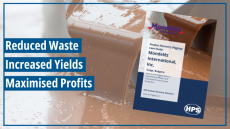Buhler opens Asian rice extrusion plant
to be enriched with vitamins.
Vitamins and minerals tend to be lost during the whitening and polishing of rice, but a new extrusion mechanism has been developed that transforms rice brokens into vitamin-enriched rice pellets.
The resulting rice pellets can be customised in terms of colour, shape, and size. The composition of their component substances and their cooking characteristics can also be tailor-made.
In China, a production plant is currently under construction, which will apply this new form of enrichment and admixture. Buhler, which has developed this new technology with DSM Nutritional Products, believes that the technique could have a number of interesting applications in rice processing.
For example the preparation of congee, the typical Chinese rice gruel, usually takes up to a few hours, but this can be considerably reduced through the cooking extrusion process.
For the 3 billion people living in Asia, rice provides one-third or more of the dietary energy requirement. And for several South and Southeast Asian countries within that region, rice accounts for between two-fifths and four-fifths of the food energy and protein requirements.
Depending on the specific process applied, the extruded product may serve as instant rice pellets, as quick-cooking rice pellets, or as a product for admixture to natural rice.
The process works like this. Rice brokens obtained during whitening, which up to now were usually sold as a low-grade animal feed, are finely ground and transformed by cooking extrusion into rice-like grains.
Unlike conventional means, in which, say, a vitamin mix is added to the rice in the form of a powder or sprayed directly onto the rice, the Buhler/DSM process integrates the vital substances in the extruded rice grains themselves.
This, claims Buhler, conserves most of the sensitive vitamins during storage, washing and even cooking, and results in more efficient rice processing.
Quick cooking rice for example, which can be cooked within eight to 14 minutes after undergoing various thermal processes, has become hugely popular. The rice pellets used for quick cooking rice need to be barley distinguishable from natural rice. This is especially significant as quick-cooking rice pellets are also marketed in transparent packaging.
Instant rice ready for consumption within a very short time after hot water has been poured over it can also be achieved through cooking extrusion.
However, such rice products differ very widely in their visual appearance from natural rice grains. The addition of water during preparation, called rehydration, then produces rice-like textures.
The visual similarity of instant rice pellets to natural rice is not so important though, since the instant pellets are typically already pre-mixed with the other ingredients of the meal in the package and only require hot or boiling water for their preparation.
Buhler claims that it is possible to enrich the rice pellets with various micronutrients such as vitamin A and the vitamins of the B complex in addition to minerals and trace elements. But in addition, proteins, essential amino acids, fatty acids, and antioxidants plus probiotic and prebiotic ingredients can also be added.







